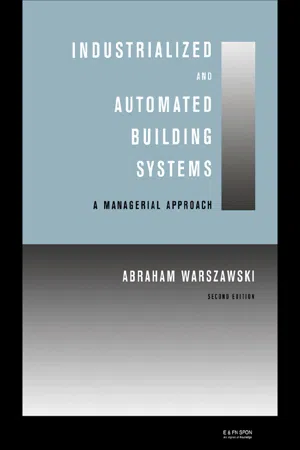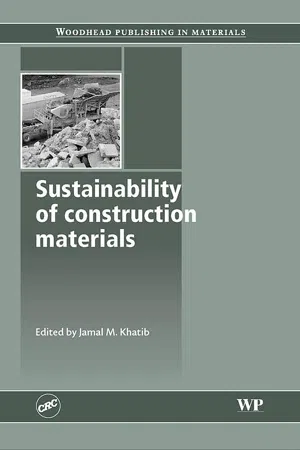Concrete Manufacturing
Concrete manufacturing involves the process of producing concrete, a versatile construction material made from a mixture of cement, water, and aggregates such as sand and gravel. The manufacturing process typically includes batching, mixing, transporting, and curing to create the final product. This industry plays a crucial role in infrastructure development and construction projects worldwide.
4 Key excerpts on "Concrete Manufacturing"
- eBook - ePub
Industrialized and Automated Building Systems
A Managerial Approach
- Abraham Warszawski(Author)
- 2003(Publication Date)
- Routledge(Publisher)
...Chapter 5 Production Technology 5.1 Introduction The production technology of prefabricated building components is characterized by the following features: The materials used for production. The sequence of operations that compose the production process. The equipment used for this purpose. Although the prefabrication principles discussed in this book can be applied to various production technologies, the currently prevailing one uses concrete as its main material. Precast concrete technology is therefore the subject of this chapter, with particular reference to the following topics: Main materials used in production—cement, aggregates, admixtures, reinforcing steel. Preparation of concrete mix. Concrete curing. Production of main concrete elements—the process and equipment used for this purpose. Erection and jointing of elements onsite. This chapter is descriptive in nature and briefly reviews the elements of concrete production technology essential for understanding the prefabrication process. A more fundamental treatment of this subject can be found in Refs. [ 5, 6, 15 ] and other texts. A specific reference to concrete production in prefabrication plant can be found in Refs. [ 3, 18 ]. 5.2 Materials Matrials used for precasting of concrete elements include concrete mix and its components—cement, aggregates, reinforcing steel, and various admixtures. A very brief review of these materials together with a reference to their detailed specifications will follow. Different fixtures—electrical conduits, plumbing, window and door frames, inserts, bolts, and hangers—which are embedded in concrete or attached to it, constitute distinct industrial products governed by their own production procedures. Cement The currently used cements may be broken down by their composition into the following main categories [ 1 ]: Portland cements made of pulverized clinker...
- eBook - ePub
- P.K. Jayasree, K Balan, V Rani(Authors)
- 2021(Publication Date)
- CRC Press(Publisher)
...Next, the other ingredients—aggregates (such as sand or gravel), admixtures (chemical additives), any necessary fibers—are measured and dry-mixed together. Then the required proportion of water is added to the dry mix and mixed thoroughly to form the concrete. The concrete is then shipped to the work site and placed, compacted, and cured. 9.6.2 Transport to Work Site Once the concrete mixture is ready, it is transported to the work site. There are many methods of transporting concrete, including wheelbarrows, buckets, belt conveyors, special trucks, and pumping. Pumping transports large quantities of concrete over large distances through pipelines using a system consisting of a hopper, a pump, and the pipes. Pumps come in several types—the horizontal piston pump with semi-rotary valves and small portable pumps called squeeze pumps. A vacuum provides a continuous flow of concrete, with two rotating rollers squeezing a flexible pipe to move the concrete into the delivery pipe. 9.6.3 Placing and Compacting Once at the site, the concrete must be placed and compacted. These two operations are performed almost simultaneously. Placing must be done so that segregation of the various ingredients is avoided and full compaction is achieved eliminating the air bubbles. Vibrators are used to densify the concrete. 9.6.4 Curing Once it is placed and compacted, the concrete must be cured before it is finished to make sure that it does not dry too quickly. As the cement solidifies, the concrete shrinks. To minimize this problem, concrete must be kept damp during the initial days it requires to set and harden. 9.6.5 Quality Control Concrete manufacturers expect their raw material suppliers to supply a consistent, uniform product. At the cement production factory, the proportions of the various raw materials that go into cement must be checked to achieve a consistent kiln feed, and samples of the mix are frequently examined using X-ray fluorescence analysis...
- eBook - ePub
- Jamal Khatib(Author)
- 2009(Publication Date)
- Woodhead Publishing(Publisher)
...The aggregate part of the concrete normally accounts for 70–75% of its volume and therefore the environmental issues of aggregate production strongly influence concrete production. Furthermore, cement production is associated with high energy consumption and CO 2 emissions. Thus, the sustainability of concrete as a material is strongly influenced by the cement industry and the aggregate industry. However, since concrete is most often reinforced by means of steel bars, this also needs to be included in a total sustainability analysis. The amount of steel present in a reinforced concrete structure varies according to its purpose and the design conditions, but a rebar content of 200 kg/m 3 concrete is not unusual for nonprestressed structures. 5.3.1 Cement Production of cement Cement is made by heating limestone and other raw materials to 1400–1450 °C in a rotary kiln. Fossil fuels such as coal and oil have usually been used to provide heat for the burning process. In the process, limestone (CaCO 3) first breaks down to calcium oxide (CaO) and carbon dioxide (CO 2). CaO then further reacts to form the Portland clinker. The clinker is ground with a small amount of gypsum into a powder, i.e. the cement. Some types of common cement also include other constituents in addition to clinker and gypsum such as limestone, granulated blast furnace slag, FA or other mineral by-products from industrial processes. Such cements are called blended cements, see the following section. The most important environmental effects of cement production can be divided into: (a) use of energy (fuel, electricity) and emissions associated with this (CO 2, SO 2 and dust); (b) use of natural raw materials (mainly limestone). In modern cement production the total CO 2 emission per metric tonne of clinker produced is normally 800–900 kg. Approximately 45% of this is from the calcinations process, i.e...
- eBook - ePub
- Greg McNally(Author)
- 2017(Publication Date)
- CRC Press(Publisher)
...It is used for filling narrow voids in fractured rockmasses, either to reduce their permeability or to increase their stiffness. A wide variety of other characteristics such as low density (for high-rise building floors), high density (for breakwater blocks) and thermal insulating properties can be designed into concrete mixes. Mixes can also be made ‘lean’ and therefore cheaper, with a low cement content; porous, by reducing the fines content or by foaming; frost-resistant, by air entrainment; and highly impervious, to resist surface attack by chemicals and salt water. This chapter presents an introduction to concrete technology, emphasizing the effects of aggregate properties on those of the fresh (wet) and hardened product. Cement is dealt with in Chapter 15. Much more comprehensive discussions of both cement properties and concrete technology in all its aspects are provided in the standard texts by Neville (1981), Neville and Brooks (1987) and Day (1995), in manuals such as that of the US Bureau of Reclamation (1975), and in trade publications. 8.1 CONCRETE AGGREGATES Mineral aggregates make up 60–80% of concrete by volume because they are cheaper than cement, reduce drying shrinkage and improve the properties of the finished product. Normally two size fractions are combined in the mix, coarse aggregate (gravel) and fine aggregate (sand plus fine gravel up to about 5mm), as illustrated in Figure 8.2. A wide variety of medium- to fine-grained igneous and metamorphic rocks, and even a few well-indurated sedimentary ones, are used for making coarse aggregate. River gravels (Chapter 3) were formerly the preferred sources of concrete aggregate—because both coarse and fine sizes occur together, no blasting and minimal crushing are required, and particles are likely to be tough and durable...



